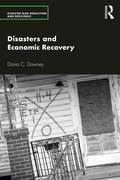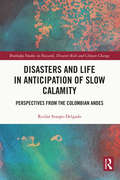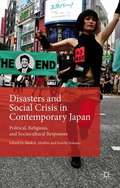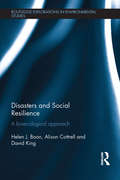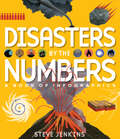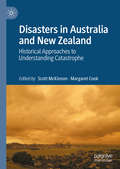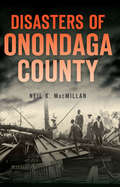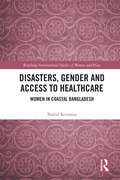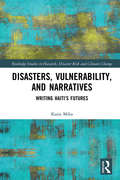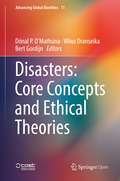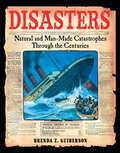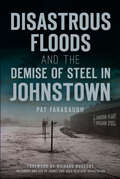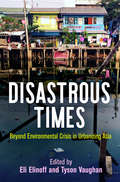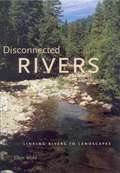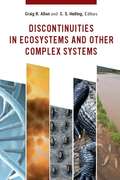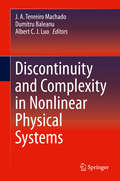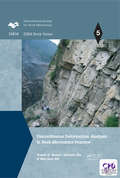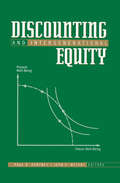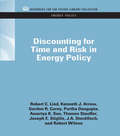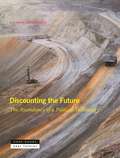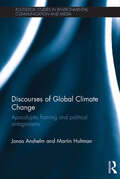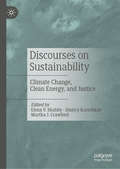- Table View
- List View
Disasters and Economic Recovery (Disaster Risk Reduction and Resilience)
by Davia C. DowneyDisasters and Economic Recovery provides perspectives on the economic issues that emerge before, during, and after natural disasters in an international context, by assessing the economic development patterns that emerge before and after disaster. This book will provide a historical overview of emergency management policy and previous responses to disasters in each country, as well as the policy learning that occurred in each case leading up to the disasters under analysis. The book highlights four cases: New Orleans; Christchurch, New Zealand; the Japan earthquake and tsunami; and Hurricane Sandy in the Northeastern United States. The book places important focus on the specific collaborative developments unique to the rebuilding of each place’s economy post-disaster. Using time-series data, the book shows the emergence of new industries and job hiring patterns in the immediate aftermath, as well as provides a picture of the economic performance of each country in the years following each event. Looking at the economic development policies pre- and post-disaster, readers will glean important lessons on how to build resilient economies within the disaster framework, highlighting the differences in approaches to rebuilding local economies in places with varying levels of governmental capacity post-disaster to inform policymakers, scholars, and the disaster relief community as they plan their response to future disasters.
Disasters and Life in Anticipation of Slow Calamity: Perspectives from the Colombian Andes (Routledge Studies in Hazards, Disaster Risk and Climate Change)
by Reidar Staupe-DelgadoThe book provides insights into community narratives concerning life in the face of creeping calamities through a case study from the Colombian Andes. It sets out to make sense of the lived experience of disasters that are slowly unfolding as well disasters that have not yet occurred. This book explores what it means to live in anticipation of disaster and in anticipation of an uprooting of community, sense of self, and sense of belonging. It questions whether community resilience is a useful concept in the context of slow-onset geological hazards for which few viable solutions are available. The book forces us to think about how resettlement and displacement functions in the context of slow calamities, which presents distinct challenges, mainly related to lower political saliency than what is usually the case in emergencies. The book thus also has implications for how we think about the adverse impacts of climate change. By raising new questions on the nature of disasters and calamities and how we experience them, the book explores the challenges and tensions surrounding governance and governmentality. The inter-disciplinary blend of practice-oriented and conceptual reflections will appeal to academics in postgraduate and postdoctoral research in social sciences, specifically, disaster research, geography, and research fields centred on natural hazards and disasters.
Disasters and Social Capital: Risk Reduction and Geographical Legacies in the Philippines (Disaster Risk Reduction and Resilience)
by Justin VeutheyThis book analyzes social capital and preparations for natural hazards in the Philippines. It emphasizes the importance of inequalities, contextualization, and scale, while also underlining the significance of historical and political contexts to better understand social dynamics. Social capital continues to be a debated concept, but it can be useful for thinking about how human societies interact with natural hazards. This book contributes to the growing scientific inquiries which have begun to address the connections between social capital and “natural” disasters. Chapters explore the links between these two fields of knowledge by analyzing the Filipino situation in general, as well as detailing a specific case study of a rural municipality in the Eastern Visayas region. The book’s central argument is that economic inequality is detrimental to social capital which then has negative repercussions on preparing for natural hazards. In an analysis at several geographical scales, Justin shows how inequality, via social capital, makes societies more at risk of having natural hazards turn into disasters. The book argues that a cautious use of the concept of social capital, which is cognizant of the historical and geographical complexities of the context it is applied to, has the potential to improve the way people collectively prevent hazards from turning into disasters. It is essential reading for students, scholars, disaster risk management practitioners, policymakers, and anyone seeking to understand the complexities of climate change, inequality, and crisis resilience.
Disasters and Social Crisis in Contemporary Japan: Political, Religious, And Sociocultural Responses
by Koichi Nakano Mark MullinsJapan was shaken by the 'double disaster' of earthquake and sarin gas attack in 1995, and in 2011 it was hit once again by the 'triple disaster' of earthquake, tsunami, and nuclear meltdown. This international, multi-disciplinary group of scholars examines the state and societal responses to the disasters and social crisis.
Disasters and Social Resilience: A bioecological approach (Routledge Explorations in Environmental Studies)
by David King Helen J. Boon Alison CottrellThe interconnectedness of communities, organisations, governing bodies, policy and individuals in the field of disaster studies has never been accurately examined or comprehensively modelled. This kind of study is vital for planning policy and emergency responses and assessing individual and community vulnerability, resilience and sustainability as well as mitigation and adaptation to climate change impacts; it therefore deserves attention. Disasters and Social Resilience fills this gap by introducing to the field of disaster studies a fresh methodology and a model for examining and measuring impacts and responses to disasters. Urie Bronfenbrenner’s bioecological systems theory, which is used to look at communities holistically, is outlined and illustrated through a series of chapters, guiding the reader from the theory's underpinnings through research illustrations and applications focused on each level of Bronfenbrenner’s ecosystems, culminating in an integration chapter. The final chapter provides policy recommendations for local and national government bodies and emergency providers to help individuals and communities prepare and withstand the effects of a range of disasters. This book will be of great interest to scholars and students of disaster and emergency management, disaster readiness and risk reduction (DRR), and to scholars and students of more general climate change and sustainability studies.
Disasters by the Numbers: A Book of Infographics
by Steve JenkinsAn amazing look at Earth&’s natural disasters as seen through numbers, facts, and stunning infographics from Caldecott Honor–winning author-illustrator Steve Jenkins! From Caldecott Honor–winning author-illustrator Steve Jenkins comes an in-depth look at the world's natural disasters, broken down into four distinct categories: earth, weather, life, and space. From timelines of causes and outcomes of each disaster, graphs highlighting humans' effect on the earth, and a text teeming with fresh, unexpected, and accurate information ready for readers to easily devour, Disasters by the Numbers is unmatched and sure to wow fans old and new.
Disasters in Australia and New Zealand: Historical Approaches to Understanding Catastrophe
by Scott McKinnon Margaret CookDisasters in Australia and New Zealand brings together a collection of essays on the history of disasters in both countries. Leading experts provide a timely interrogation of long-held assumptions about the impacts of bushfires, floods, cyclones and earthquakes, exploring the blurred line between nature and culture, asking what are the anthropogenic causes of ‘natural’ disasters? How have disasters been remembered or forgotten? And how have societies over generations responded to or understood disaster? As climate change escalates disaster risk in Australia, New Zealand and around the world, these questions have assumed greater urgency. This unique collection poses a challenge to learn from past experiences and to implement behavioural and policy change. Rich in oral history and archival research, Disasters in Australia and New Zealand offers practical and illuminating insights that will appeal to historians and disaster scholars across multiple disciplines.
Disasters of Onondaga County (Disaster)
by Neil K. MacmillanThe city of Syracuse and Onondaga County have a long and storied history of natural and man-made calamity. Although often considered a moderate weather region, Mother Nature has not spared it from destruction. A tornado devastated picturesque Longbranch Park in 1912, and the rare Hurricane Hazel reached Onondaga’s borders in 1954. A fire ravaged Syracuse’s famed Bastable Block building in 1923. During a children’s concert and festival, the floor of the Central Baptist Church collapsed, tragically claiming scores of lives and injuring more than one hundred. Author and historian Neil MacMillan charts the history of Onondaga County catastrophes.
Disasters, Gender and Access to Healthcare: Women in Coastal Bangladesh (Routledge International Studies of Women and Place)
by Nahid RezwanaDisasters, Gender and Access to Healthcare: Women in Coastal Bangladesh emphasizes women’s experiences in cyclone disasters being confined with gendered identity and responsibilities in developing socio-economic conditions with minimum healthcare facilities. The study is situated in the coastal region of Bangladesh, considered as one of the most disaster-prone regions in the world. Bangladesh has been working on disaster management for a long time; however, considering gender perspective, the book reveals gaps in plans and raises serious questions about the successful implementation of healthcare strategies after disasters. The book also describes the pre–during–after disaster periods showing the full picture of a disaster attack in victims’ own words. Case studies of seriously affected victims give the reader an opportunity to understand the situations created for women during a disaster attack in a remote area with poor transport and healthcare facilities. These unique research findings will contribute to the broader context of gender, disaster and health studies. This book will be helpful for university staff and students of different disciplines including Anthropology, Disaster Management, Gender Studies and Geography and South Asian Regional Studies and be invaluable reading for disaster managers, policy makers, aid workers, development partners, NGOs and government, especially in disaster-prone countries.
Disasters, Vulnerability, and Narratives: Writing Haiti’s Futures (Routledge Studies in Hazards, Disaster Risk and Climate Change)
by Kasia MikaThis book uses narrative responses to the 2010 Haiti earthquake as a starting point for an analysis of notions of disaster, vulnerability, reconstruction and recovery. The turn to a wide range of literary works enables a composite comparative analysis, which encompasses the social, political and individual dimensions of the earthquake. This book focuses on a vision of an open-ended future, otherwise than as a threat or fear. Mika turns to concepts of hinged chronologies, slow healing and remnant dwelling. Weaving theory with attentive close-readings, the book offers an open-ended framework for conceptualising post-disaster recovery and healing. These processes happen at different times and must entail the elimination of compound vulnerabilities that created the disaster in the first place. Challenging characterisations of the region as a continuous catastrophe this book works towards a bold vision of Haiti’s and the Caribbean’s futures. The study shows how narratives can extend some of the key concepts within discipline-bound approaches to disasters, while making an important contribution to the interface between disaster studies, postcolonial ecocriticism and Haitian Studies.
Disasters: Core Concepts and Ethical Theories (Advancing Global Bioethics #11)
by Bert Gordijn Dónal P. O’Mathúna Vilius DranseikaThis Open Access Book is the first to examine disasters from a multidisciplinary perspective. Justification of actions in the face of disasters requires recourse both to conceptual analysis and ethical traditions. Part 1 of the book contains chapters on how disasters are conceptualized in different academic disciplines relevant to disasters. Part 2 has chapters on how ethical issues that arise in relation to disasters can be addressed from a number of fundamental normative approaches in moral and political philosophy. This book sets the stage for more focused normative debates given that no one book can be completely comprehensive. Providing analysis of core concepts, and with real-world relevance, this book should be of interest to disaster scholars and researchers, those working in ethics and political philosophy, as well as policy makers, humanitarian actors and intergovernmental organizations..
Disasters: Natural and Man-Made Catastrophes Through the Centuries
by Brenda Z. GuibersonNatural and man-made disasters have the power to destroy thousands of lives very quickly. Both as they unfold and in the aftermath, these forces of nature astonish the rest of the world with their incredible devastation and magnitude. In this collection of ten well-known catastrophes such as the great Chicago fire, the sinking of the Titanic, and hurricane Katrina, Brenda Guiberson explores the causes and effects, as well as the local and global reverberations of these calamitous events. Highlighted with photographs and drawings, each compelling account tells the story of destruction and devastation, and most especially, the power of mankind to persevere in the face of adversity.
Disastrous Floods and the Demise of Steel in Johnstown (Disaster)
by Pat FarabaughJohnstown is synonymous with floodwaters and steel. When the city was decimated by a flood of biblical proportions in 1889, it was considered one of the worst natural disasters in American history and gained global attention. Sadly, that deluge was only the first of three major floods to claim lives and wreak havoc in the region. The destruction in the wake of the St. Patrick's Day flood in 1936 was the impetus for groundbreaking federal and local flood control measures. Multiple dam failures, including the Laurel Run Dam in July 1977, left a flooded Johnstown with a failing steel industry in ruins. Author Pat Farabaugh charts the harrowing history of Johnstown's great floods and the effects on its economic lifeblood.
Disastrous Times: Beyond Environmental Crisis in Urbanizing Asia (Critical Studies in Risk and Disaster)
by Eli Elinoff and Tyson VaughanAcross contemporary Asia, each day dawns with a new story about living in an era of profound environmental change. Rapid transformations in the landscape, society, and technology produce new conflicts that are experienced at nearly every scale of life in the region. Environmental change is marked in square kilometers or micrometers, in cities or in households, within national boundaries and beyond. These changes appear in the form of radical ruptures wrought both by spectacular catastrophes like massive floods or tsunamis and by slow tragedies like the widening epidemic of asthma or the grinding processes of land dispossession. Each of these scales and phenomena reveals what it is to live in disastrous times.This book explores how people across Asia live through and make sense of the environmental ruptures that now shape the region and asks how we might analyze this moment of disruption and risk. Global environmental shifts such as climate change are usually linked to large-scale practices such as industrialization, urbanization, and global capitalism. Here, in contrast, contributors illustrate how understanding the practical, political, and ethical consequences of living in a moment of planetary change—or intervening in its course—requires engaging with the human-scale actions and specific policies that both shape and respond to such transformations at an everyday level. Coastal residents of routinely flooded Semarang, eco-conscious retirees in a Chinese suburb, and cyclists navigating air pollution in Kolkata each experience environmental risk and change in highly situated and specific ways; yet attending to their lived, quotidian experiences enables us to apprehend the complex processes that are profoundly changing the planet.Contributors: Nikolaj Blichfeldt, Vivian Choi, Eli Elinoff, Jenny Elaine Goldstein, Andrew Alan Johnson, Samuel Kay, Lukas Ley, Edmund Joo Vin Oh, Malini Sur, Tyson Vaughan.
Disconnected Rivers: Linking Rivers to Landscapes
by Ellen E. WohlThis important and accessible book surveys the history and present condition of river systems across the United States, showing how human activities have impoverished our rivers and impaired the connections between river worlds and other ecosystems. Ellen Wohl begins by introducing the basic physical, chemical, and biological processes operating in rivers. She then addresses changes in rivers resulting from settlement and expansion, describes the growth of federal involvement in managing rivers, and examines the recent efforts to rehabilitate and conserve river ecosystems. In each chapter she focuses on a specific regional case study and describes what happens to a particular river organism--a bird, North America's largest salamander, the paddlefish, and the American alligator--when people interfere with natural processes.
Discontinuities in Ecosystems and Other Complex Systems
by C. S. Holling Craig R. AllenA Major Contribution to Theoretical Ecology
Discontinuities in Ecosystems and Other Complex Systems (Complexity in Ecological Systems)
by C. S. Holling Craig R. Allen Eds.Following the publication of C. S. Holling's seminal work on the relationship between animal body mass patterns and scale-specific landscape structure, ecologists began to explore the theoretical and applied consequences of discontinuities in ecosystems and other complex systems. Are ecosystems and their components continuously distributed and do they adhere to scaling laws, or are they discontinuous and more complex than early models would have us believe? The resulting propositions over the structure of complex systems sparked an ongoing debate regarding the mechanisms generating discontinuities and the statistical methods used for their detection.This volume takes the view that ecosystems and other complex systems are inherently discontinuous and that such fields as ecology, economics, and urban studies greatly benefit from this paradigm shift. Contributors present evidence of the ubiquity of discontinuous distributions in ecological and social systems and how their analysis provides insight into complex phenomena. The book is divided into three sections. The first focuses on background material and contrasting views concerning the discontinuous organization of complex systems. The second discusses discontinuous patterns detected in a number of different systems and methods for detecting them, and the third touches on the potential significance of discontinuities in complex systems. Science is still dominated by a focus on power laws, but the contributors to this volume are convinced power laws often mask the interesting dynamics of systems and that those dynamics are best revealed by investigating deviations from assumed power law distributions.In 2008, a grand conference on resilience was held in Stockholm, hosting 600 participants from around the world. There are now three big centers established with resilience, the most recent one being the Stockholm Resilience Center, with others in Australia (an international coral reef center), Arizona State University's new sustainability center focusing on anthropology, and Canada's emerging social sciences and resilience center. Activity continues to flourish in Alaska, South Africa, and the Untied Kingdom, and a new center is forming in Uruguay.
Discontinuity and Complexity in Nonlinear Physical Systems
by Dumitru Baleanu J. A. Tenreiro Machado Albert C J LuoDiscontinuity in Nonlinear Physical Systems explores recent developments in experimental research in this broad field, organized in four distinct sections. Part I introduces the reader to the fractional dynamics and Lie group analysis for nonlinear partial differential equations. Part II covers chaos and complexity in nonlinear Hamiltonian systems, important to understand the resonance interactions in nonlinear dynamical systems, such as Tsunami waves and wildfire propagations; as well as Lev flights in chaotic trajectories, dynamical system synchronization and DNA information complexity analysis. Part III examines chaos and periodic motions in discontinuous dynamical systems, extensively present in a range of systems, including piecewise linear systems, vibro-impact systems and drilling systems in engineering. And in Part IV, engineering and financial nonlinearity are discussed. The mechanism of shock wave with saddle-node bifurcation and rotating disk stability will be presented, and the financial nonlinear models will be discussed.
Discontinuous Deformation Analysis in Rock Mechanics Practice (ISRM Book Series)
by Yossef H. Hatzor Guowei Ma Gen-hua ShiThe numerical, discrete element, Discontinuous Deformation Analysis (DDA) method was developed by Dr. Gen-hua Shi while he was working at the University of California, Berkeley, under the supervision of Prof. Richard E. Goodman in the late 1980s. Two-dimensional DDA was published in 1993 and three-dimensional DDA in 2001. Since its publication DDA has been verified, validated and applied in numerous studies worldwide and is now considered a powerful and robust method to address both static and dynamic engineering problems in discontinuous rock masses.In this book Yossef H. Hatzor and Guowei Ma, co-chairs of the International Society for Rock Mechanics (ISRM) Commission on DDA, join Dr. Shi in authoring a monograph that presents the state of the art in DDA research. A comprehensive discussion of DDA development since its publication is provided in Chapter 1, followed by concise reviews of 2D and 3D DDA in chapters 2 and 3. Procedures to select geological and numerical input parameters for DDA are discussed in Chapter 4, and DDA validation and verification is presented in Chapter 5. Applications of DDA in underground and rock slope engineering projects are discussed in chapters 6 and 7. In Chapter 8 the novel contact theory recently developed by Dr. Shi is published in its complete form, for the first time. This book is published within the framework of the ISRM Book Series and is the contribution of the ISRM DDA Commission to the international rock mechanics community.
Discounting and Intergenerational Equity
by Paul R. Portney John P. WeyantThe full effects of decisions made today about many environmental policies -including climate change and nuclear waste- will not be felt for many years. For issues with long-term ramifications, analysts often employ discount rates to compare present and future costs and benefits. This is reasonable, and discounting has become a procedure that raises few objections. But are the methods appropriate for measuring costs and benefits for decisions that will have impacts 20 to 30 years from now the right ones to employ for a future that lies 200 to 300 years in the future? This landmark book argues that methods reasonable for measuring gains and losses for a generation into the future may not be appropriate when applied to a longer span of time. Paul Portney and John Weyant have assembled some of the world's foremost economists to reconsider the purpose, ethical implications, and application of discounting in light of recent research and current policy concerns. These experts note reasons why conventional calculations involved in discounting are undermined when considering costs and benefits in the distant future, including uncertainty about the values and preferences of future generations, and uncertainties about available technologies. Rather than simply disassemble current methodologies, the contributors examine innovations that will make discounting a more compelling tool for policy choices that influence the distant future. They discuss the combination of a high shout-term with a low long-term diescount rate, explore discounting according to more than one set of anticipated preferences for the future, and outline alternatives involving simultaneous consideration of valuation, discounting and political acceptability.
Discounting for Time and Risk in Energy Policy: Discounting For Time And Risk In Energy Policy (RFF Energy Policy Set)
by Partha Dasgupta Joseph E. Stiglitz Kenneth J. Arrow Robert C. Lind Gordon R. Corey Amartya K. Sen Thomas Stauffer J.A. StockfischThis is a collection of theoretical papers, including contributions by Partha Dasgupta and three Nobel prize-winning economists: Kenneth Arrow, Amartya Sen, and Joseph Stiglitz. Originally published in 1982.
Discounting the Future: The Ascendancy of a Political Technology
by Liliana DoganovaA pioneering exploration of the defining traits and contradictions of our relationship to the future through the lens of discountingForest fires, droughts, and rising sea levels beg a nagging question: have we lost our capacity to act on the future? Liliana Doganova&’s book sheds new light on this anxious query. It argues that our relationship to the future has been trapped in the gears of a device called discounting. While its incidence remains little known, discounting has long been entrenched in market and policy practices, shaping the ways firms and governments look to the future and make decisions accordingly. Thus, a sociological account of discounting formulas has become urgent.Discounting means valuing things through the flows of costs and benefits that they are likely to generate in the future, with these future flows being literally dis-counted as they are translated in the present. How have we come to think of the future, and of valuation, in such terms? Building on original empirical research in the historical sociology of discounting, Doganova takes us to some of the sites and moments in which discounting took shape and gained momentum: valuation of European forests in the eighteenth and nineteenth centuries; economic theories devised in the early 1900s; debates over business strategies in the postwar era; investor-state disputes over the nationalization of natural resources; and drug development in the biopharmaceutical industry today. Weaving these threads together, the book pleads for an understanding of discounting as a political technology, and of the future as a contested domain.
Discourses of Global Climate Change: Apocalyptic framing and political antagonisms (Routledge Studies in Environmental Communication and Media)
by Martin Hultman Jonas AnshelmThis book examines the arguments made by political actors in the creation of antagonistic discourses on climate change. Using in-depth empirical research from Sweden, a country considered by the international political community to be a frontrunner in tackling climate change, it draws out lessons that contribute to the worldwide environmental debate. The book identifies and analyses four globally circulated discourses that call for very different action to be taken to achieve sustainability: Industrial fatalism, Green Keynesianism, Eco-socialism and Climate scepticism. Drawing on risk society and post-political theory, it elaborates concepts such as industrial modern masculinity and ecomodern utopia, exploring how it is possible to reconcile apocalyptic framing to the dominant discourse of political conservatism. This highly original and detailed study focuses on opinion leaders and the way discourses are framed in the climate change debate, making it valuable reading for students and scholars of environmental communication and media, global environmental policy, energy research and sustainability.
Discourses on Sustainability: Climate Change, Clean Energy, and Justice
by Martha J. Crawford Elena V. Shabliy Dmitry KurochkinThis volume presents an in-depth analysis of climate change problems and discusses the proliferation of renewable energy worldwide—in conjunction with such important questions as social justice and economic growth, providing an interdisciplinary approach to sustainable development. Exploring various responses to human-induced climate change, the book offers a critical reflection on climate change and clean energy and highlights the fundamental problems of international energy justice and human rights. Examining these and other climate-related issues from legal, business, political, and scientific perspectives, the volume also analyzes the impact of economic factors and policies on climate change mitigation and adaptation.
Discover National Monuments
by Cynthia Light Brown Blair SheddFascinating facts about America's most popular natural landmarks provide the backbone for this fun-filled collection of activities that replicate the organic processes that formed them. Interspersed with history, factoids, and sidebars, this engaging reference explores scientific concepts, such as the formation of coral reefs and the cause of volcanic eruptions. Each monument-from the Lava Beds to the Petrified Forest-is showcased in a graphic multipage spread and is followed by hands-on experiments, allowing children to make their own stalactites and discover how a river can erode rock into a canyon. Expressing true appreciation for the United States' natural wonders, this comprehensive guide clearly illustrates their formation, from glittering caves to giant trees.
